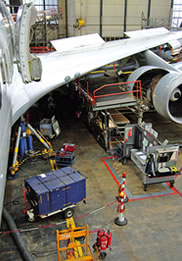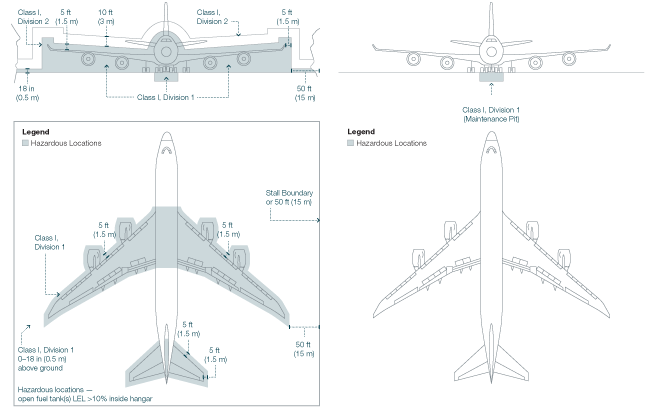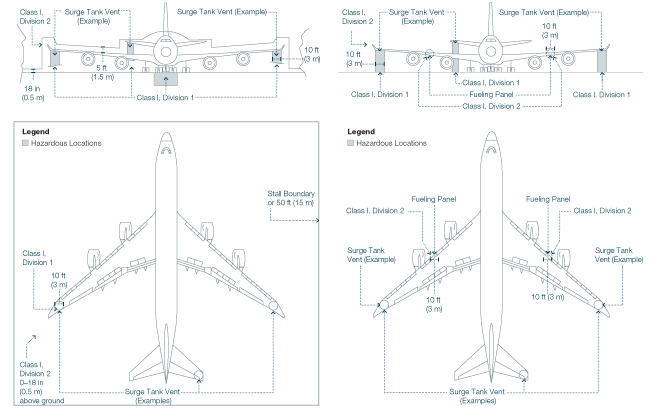

Boeing recently released a service letter to help operators and maintenance, repair, and overhaul (MRO) organizations determine when an airplane with open fuel tanks can be considered fire safe.
By Michael D. Jones, Service Engineer
A new service letter on open fuel-tank flammability gives operators more maintenance flexibility.
Boeing aircraft maintenance manuals (AMMs) provide specific procedures for opening and purging fuel tanks on Boeing airplanes. During the purging process, the areas around an airplane are defined as Class I, Division 1 or Division 2 flammability zones. Only explosion-proof equipment can be used within these flammability zones, which extend to a 50-foot radius around the airplane. The definitions for Class I, Division 1 and Division 2 flammability zones (per National Fire Protection Association 70, Article 500) are as follows:
- Class I, Division 1 hazardous locations:
- Locations where ignitable concentrations of flammable gases or vapors can exist under standard operating conditions.
- Locations where ignitable concentrations of flammable gases or vapors may exist frequently because of repair or maintenance operations.
- Locations where ignitable concentrations of flammable gases or vapors can exist because of leakage.
- Locations or processes that can release ignitable concentrations of flammable gases or vapor, and can also cause failure of electrical equipment at the same time.
- Class I, Division 2 hazardous locations (or equivalent standard): Locations where flammable liquids or gases are handled, processed, or used, but where the liquid, vapors, or gases will usually be in closed containers or closed systems. The containers or systems will not allow the release of liquid, gas, or vapor in sufficient quantity to produce an ignitable fuel and air mixture unless the container or system fails or is damaged.
The AMM provides the procedure and the associated warnings and cautions for purging fuel tanks. The AMM does not define when the purging procedure can be considered complete or when areas around the fuel tank can be considered fire safe. This article provides information regarding the flammability of open fuel tanks and airplane maintenance activities around these open tanks.
In June 2010, Boeing released a multi-model service letter that defines when the purging process is complete and when the areas around an airplane can be considered fire safe. Airlines and MROs can use this service letter to develop or revise their own requirements and policies regarding the flammability zones around airplanes. The service letter only addresses the flammability of the areas around an airplane — it does not address maintenance within the fuel tank. Personnel must continue to obey the warnings and cautions in the AMM fuel tank entry procedures.
Clarifying maintenance procedures near open fuel tanks
In response to operator requests, Boeing has released a service letter to further define the flammability of airplane fuel tanks (see fig. 1). The service letter, released in 2010, provides guidance on the flammability of the areas around an airplane, for open and closed fuel tanks, and for hangar and ramp operations.
Figure 1: Service letter numbers by airplane model
| MODEL | SERVICE LETTER | MODEL | SERVICE LETTER | |
| 707 | 707-SL-28-020-B | 787 | 787-SL-28-001-B | |
| 717 | 717-SL-28-120-B | DC-8 | DC-8-SL-28-111-B | |
| 727 | 727-SL-28-042-B | DC-9 | DC-9-SL-28-111-B | |
| 737 | 737-SL-28-082-B | DC-10 | DC-10-SL-28-120-B | |
| 747 | 747-SL-28-107-B | MD-10 | MD-10-SL-28-117-B | |
| 757 | 757-SL-28-046-B | MD-11 | MD-11-SL-28-128-B | |
| 767 | 767-SL-28-044-B | MD-80 | MD-80-SL-28-113-B | |
| 777 | 777-SL-28-027-B | MD-90 | MD-90-SL-28-114-B |
By defining when the areas around an airplane are flammable and when these areas can be considered fire safe, this new service letter gives airlines and MROs additional flexibility in their maintenance operations.
The content of the service letter is based on the following National Fire Protection Association (NFPA) documents, which provide the fire protection standards for design and maintenance practices in the United States:
- NFPA 70, Article 500 (Hazardous Locations).
- NFPA 70, Article 515 (Electrical — Airplane Hangars).
- NFPA 407 (Airplane Fuel Servicing).
- NFPA 409 (Airplane Hangars).
- NFPA 410 (Airplane Maintenance).
Fire safe conditions
The areas around airplane fuel tanks are considered flammable until all the fuel in an airplane is removed (i.e., all tanks are pressure defueled, residual fuel is removed from the sump drains, and any trapped fuel is manually removed), and the tanks are fully purged. When the tanks are defueled, sumped, and mopped, the airplane can be considered unfueled (NFPA 410, 3.3.28). Purging is considered complete when the measured lower explosive limit (LEL) is confirmed to be 10 percent or less. Prior to the airplane being unfueled and purged, maintenance personnel must maintain the Class I, Division 1 and Division 2 hazardous locations around the airplane. If the airplane has one tank defueled and one or more tanks fueled, the airplane is considered fueled and the Class I, Division 1 and Division 2 flammability zones must be maintained.
After the fuel is removed from all of the fuel tanks using these methods (i.e., the airplane is unfueled), and the tanks are purged (i.e., LEL is confirmed to be less than 10 percent), then the areas around the airplane can be considered fire safe. At this point, normal airplane maintenance can be performed without the Class I, Division 1 and Division 2 restrictions. Maintenance personnel must check the LEL inside the fuel tanks and around the airplane at floor level periodically. Any maintenance pits or tunnels must also be checked for flammable vapors. Even after the areas around the airplane are fire safe, Boeing recommends that the tanks continue to be ventilated while the fuel tanks are open.
|
Figure 2: Hazardous locations: open fuel tanks — before the airplane is purged and unfueled Only explosion-proof equipment can be used within these flammability zones, which extend to a 50-foot (15-meter) radius around the airplane. |
Figure 3: Hazardous locations: open fuel tanks — after the airplane is purged and unfueled After all of the fuel is removed from all of the fuel tanks and the tanks are purged, the airplane can be considered in fire safe condition. |
Airlines and MROs must also consider potential requirements from insurance carriers, local governments, and other entities when developing their own policies.
Maintenance activities with closed fuel tanks
In general, airplanes with closed fuel tanks are subject to fewer restrictions both in a hangar and on the ramp.
In the hangar. There are no Boeing restrictions to applying electrical power to an airplane with closed fuel tanks. However, maintenance personnel must maintain the Class I, Division 1 and Division 2 hazardous locations around the airplane fuel tanks and along the hangar floor. Fuel vapors can escape from the airplane surge tanks. All potential ignition sources from maintenance activities and associated tooling must be outside of the Class I, Division 2 hazardous locations, unless the tooling is approved for use in a hazardous location. For example, the tooling must be certified as explosion proof.
On the ramp. There are no flammability-zone restrictions associated with ramp maintenance activities and closed fuel tanks. However, maintenance personnel must be aware that fuel vapors can escape from the airplane surge tanks, especially on a hot day and during fueling. Fuel can spill from the surge tank vents during fueling operations if the tanks are overfilled. Maintenance personnel should not use any tooling or equipment that can create an ignition source under the surge tank vent scoop or near the fueling panel.
|
Figure 4: An airplane with closed fuel tanks inside a hangar When a fueled airplane with closed fuel tanks is in a hangar, Class I, Division 1 and Division 2 hazardous locations must be maintained around airplane fuel tanks and along the hangar floor. |
Figure 5: An airplane with closed fuel tanks on a ramp Although there are no flammability zone restrictions associated with closed fuel tanks, ramp activities ignition sources should not be used under the surge tank vent scoop or near the fueling panel. |
Summary
Operators must continue to follow all the applicable warnings and cautions published in the AMM for purging the fuel tanks and for fuel tank entry. These warnings and cautions are to prevent ignition sources in the flammable vapor zones. When all the fuel is removed from an airplane’s fuel tanks, the tanks are purged, and LEL is below 10 percent, the areas around the airplane can be considered fire safe.
The service letter released in 2010 helps define when airplane fuel tanks are flammable, which can allow greater flexibility for airline and MRO operations.
For more information, please contact Michael D. Jones.



